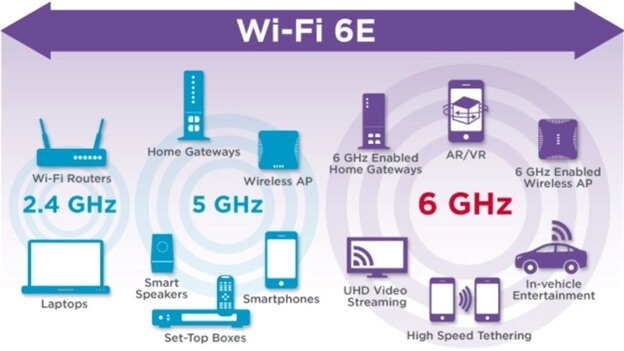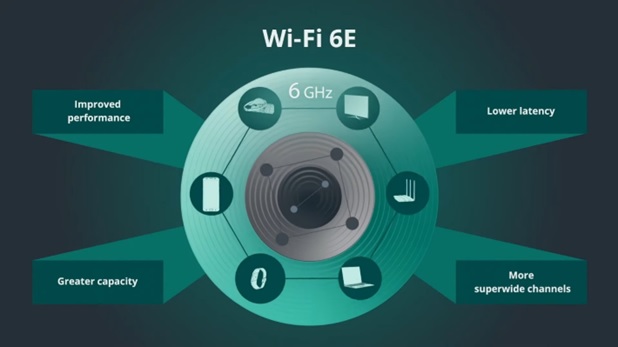Wi-Fi, aka Wireless Fidelity, is a wireless networking technology that devices use to connect to the internet. Today, almost every device we own, from smartphones to laptops to home appliances, relies on Wi-Fi for effective communication. The demand for faster and more reliable wireless connections has also increased due to digital device technology evolution. A new standard, Wi-Fi 6e, an improved version of Wi-Fi 6, promises to deliver faster speeds, better performance, and improved capabilities. We are amazed to see 6e’s performance in crowded environments. The new wireless communication standard is expected to impact how we use wireless technology in the future significantly.
What is Wi-Fi 6e?
Wi-Fi 6e is built on the IEEE 802.11ax specification and introduces a large 1.2GHz high-frequency spectrum in the range of 5.925GHz to 7.125GHz for efficient data transfer. It is the most significant expansion of Wi-Fi technology since the debut of 802.11b more than two decades ago.
Wi-Fi 6e uses a 6GHz frequency band, which does not need a license to operate and offers a much wider bandwidth than the older 2.4GHz and 5GHz Wi-Fi standards. Wider bandwidth translates into faster data transfer speeds and increased capacity for more devices to connect simultaneously. It allows additional 14 data channels that are 80 MHz wide. Wi-Fi 6e will make buffering 4K or 8K videos a thing of the past!
Before discussing the benefits, we try to make sense of the tech jargon involved. Wi-Fi 6e uses advanced technologies such as Orthogonal Frequency-Division Multiple Access (OFDMA) and Multi-User, Multiple Input, Multiple Output (MU-MIMO). Data travels wirelessly in the form of packets. OFDMA is like a carpool for the packets. It ensures optimal bandwidth usage. It works by dividing a wireless channel into smaller subcarriers and separating them into smaller resource units. MU-MIMO helps increase the number of simultaneous users connected to a Wi-Fi router. You can connect several smartphones, laptops, and tablets to the same Wi-Fi router without noticing a speed drop.
How Wi-Fi 6e compares to Wi-Fi 6 and Wi-Fi 5
Compared to Wi-Fi 6, Wi-Fi 6e offers faster speeds and improved performance in crowded environments. It also has a broader bandwidth that allows more devices to connect simultaneously.
Compared to Wi-Fi 5 (also known as 802.11ac), Wi-Fi 6e offers faster speeds, lower latency, and improved performance in crowded environments. Wi-Fi 6e has a much more available spectrum than Wi-Fi 5. This makes Wi-Fi 6e more suitable for gaming, streaming, virtual reality, and augmented reality applications requiring low latency and high-bandwidth connections.
The table below compares different Wi-Fi generations
The table below compares different Wi-Fi generations
| Wi-Fi Generation | Maximum data speed (Mbit/sec) | Radio Frequency (GHz) | MU-MIMO | IEEE Standards |
| Wi-Fi 5 | 433 to 6933 | 5 | 4 x 4 | 802.11ac |
| Wi-Fi 6 and 6e | 574 to 9608 | 2.5/5/6 | 8 x 8 | 802.11ax |
Benefits of Wi-Fi 6e
Wi-Fi 6e offers several benefits, including a better user experience and improved performance. Here are some of its significant benefits:
- Increased speed and capacity – With its 6GHz frequency band, Wi-Fi 6e offers faster data transfer speeds and increased capacity for more devices to connect simultaneously. It guarantees smoother streaming, faster file transfers, and excellent overall network performance.
- Improved performance in crowded environments – We all have been in a situation where we connected to public Wi-Fi at the airport, café, library, or hotel room and wondered why the connection was so slow. The connection speed at the Wi-Fi router level may be excellent, but due to several simultaneous connections, individual devices suffer from speed loss. Wi-Fi 6e’s efficient use of MU-MIMO and OFDMA technologies will be a game changer.
- Enhanced security features – Wi-Fi 6e includes enhanced security features such as WPA3, a more secure version of the Wi-Fi Protected Access (WPA) protocol, which provides more robust encryption and authentication for devices connecting to the network.
- Improved battery life for devices – Wi-Fi 6e uses Target Wake Time (TWT) feature, allowing devices to schedule wake-up time. This results in less power consumption and longer battery life for devices that support TWT.
- Better support for IoT – Wi-Fi 6e provides better support for IoT (Internet of Things) devices with enhanced features such as improved network efficiency and an increased number of device connections. It also has better support for low-power devices and enables more efficient device-to-device communication.

Applications of Wi-Fi 6e
Wi-Fi 6E has several potential applications in homes and businesses.
Home applications – Wi-Fi 6e can be used to improve the overall network performance. Significant advantages are – faster streaming and downloading of content and smoother online gaming. It can also support more connected devices, such as smart home devices (smart TVs, refrigerators, ovens, doorbells, etc.), making it more convenient for users.
Business applications – Wi-Fi 6e can improve the performance of networks in crowded environments, such as airports, stadiums, and conference centers. It can also be used to improve the performance of industrial IoT applications, such as those used in manufacturing and logistics.
Other applications – Public spaces like parks and malls can deploy Wi-Fi 6e to improve network performance. Wi-Fi 6e can potentially impact several industries, such as gaming, streaming, and VR / AR. Gamers can enjoy a more seamless gaming experience. Streaming of high-definition content with negligible to no buffering at all. The potential for smoother, low-latency, and high-bandwidth VR applications can guarantee a more immersive experience.

Availability of Wi-Fi 6e devices
Some of the significant manufacturers of Wi-Fi 6e devices include HP, Dell, Lenovo, Samsung, MSI, and Razer. Wi-Fi 6e routers from Intel, NETGEAR, Linksys, TP-Link, and Asus are already in the market. Smartphones from Google, Samsung, Motorola, and Asus support Wi-Fi 6e connectivity. Being a laggard on other features, the Apple iPhone is yet to get Wi-Fi 6e compatibility. However, other Apple products like iPad Pro 11-inch (4th generation), iPad Pro 12.9-inch (6th generation), and MacBook Pro 14-inch (M2 Pro or M2 Max) are already part of the 6e bandwagon. Check the Wi-Fi Alliance website for the latest Wi-Fi 6e certified devices list.
The speed of adoption for Wi-Fi 6e depends on its widespread implementation, updates to existing infrastructure, and government support. The FCC already approved the unlicensed use of the 6GHz band in 2020. The ever-increasing list of certified devices on the Wi-Fi Alliance website seems promising. However, it will take some time for Wi-Fi 6e to become widely adopted and available. The primary reason is the significant investment in infrastructure and devices to support the new standard.
Will Wi-Fi 7 take over Wi-Fi 6e?
New improvements in technology continue to happen at a rapid pace. Wi-Fi 7 is going to have the edge over Wi-Fi 6e. However, its features and implementation timelines are not yet fully known. The point is that Wi-Fi 6E and Wi-Fi 7 are not mutually exclusive. Wi-Fi 6e is an extension of Wi-Fi 6 based on the IEEE 802.11ax standard. Wi-Fi 7 is expected to be based on the IEEE 802.11be standard, which is still in development.
Wi-Fi 7 is not a direct threat to Wi-Fi 6E. Instead, it is a next-generation standard that offers improved performance and probably coexisting with Wi-Fi 6E for some time. Wi-Fi 7 does not seem to pose a risk to the growing popularity of Wi-Fi 6e. However, the adoption of Wi-Fi 6e is not yet a worldwide phenomenon. Specific geographies are still exploring legal approvals. It is backward compatible with previous standards. Hence, it will continue to be in vogue for a long time.
Wi-Fi 6E is the latest version of Wi-Fi technology that offers several improvements over its predecessors. It certainly has the potential to impact several industries, such as gaming, streaming, AR, and VR. The impact of Wi-Fi 6e technology on society is expected to be significant as it proves to be an essential enabler of technology. We hope to see its positive impact on our lives, work, and communication very soon.
loading...
loading...

